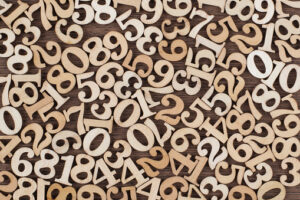Numbers around Us
TRANSCEND MEMBERS, 6 Mar 2023
Dr. Ravi P. Bhatia – TRANSCEND Media Service
We live in an environment of trees, rivers, hills, mountains. We also live with other people, animals, birds. Another entity that is around us is Numbers — one, five, two hundred, a million… The numbers exist not only in isolation but also in interaction with each other; for example when we add or subtract numbers we get another number. Similarly multiplication is a common operation; so is division to give us other numbers.
We discuss easy concepts of numbers by simple examples below.
As we walk around we can see trees alongside. There is one tree but it has several — ten or so branches that can be counted which have countless numbers of leaves some fresh, some older ones that fall down on the ground. If the tree is a fruit tree, we can get some delicious fruits such as apples or mangoes or strawberries.
If it is sunlight, the tree casts a shadow around itself. Looking at the shadow, we can roughly estimate the time of day — it is longer in the mornings and becomes shorter as the day progresses and again becomes longer towards evening time. The shadow also gives us the direction of east, as the sun rises and west as the day ends etc.
In India, there were two roadside structures called Jantar Mantar — one in Delhi and the other in Jaipur city on the North west of India. These would not only give the approximate time of the day but also helped some scholars to predict when the next lunar or solar eclipse would occur. The Jaipur Jantar Mantar was functional till recent times. Of course, today we have observatories that help us with this and related types of events.
Who were these scholars who could give us information about the time of the day or about eclipses etc? We had some wonderful mathematicians such as Aryabhatta, who discovered the number zero and its use in writing big numbers like million or billion etc. The invention and use of zero was a major step in the development of the subject. Before him, big numbers were written in a tedious and confusing manner. Another Indian mathematician was Brahmagupta who helped in writing big numbers with the help of the number zero, in about 650 AD.
Apart from the invention of zero and its applications, development of mathematics continued in India and elsewhere. In recent times a brilliant Indian mathematician S Ramanujan (1887-1920) worked in an area known as pure mathematics, developed some mathematics theorems independently and had them referred to the well known British mathematician Thomas Hardy who found them of immense value. He was subsequently honoured by being given the title of FRS (Fellow of Royal Society) by the British government ruling India then.
Simple operations of numbers (addition, subtraction, multiplication, division) can be taught to young children who are studying in junior classes. All of us deal with numbers while we buy some objects or try to estimate number of trees and their branches in a forested region. We give below simple operations of numbers. We use numbers when we refer to the birthdays of self or others.
Consider the operation of subtraction of some large numbers:
203 – 99 =? An easy manner to find the answer that even a junior student can understand is: Add 1 to both the numbers and get the answer: 204 – 100 = 104
Addition of some large numbers (ex: 97 + 67) can also be done by a trick: Add 3 to each of the numbers and then subtract 6: 100 + 70 – 6 or 170 – 6 = 164
The operation of multiplication and division can also be performed by the use of such simple means.
As discussed above all of us deal with numbers and their simple operations in everyday life. Their applications are applicable to children of even seven or eight years also who study the numbers in the form of counting and addition, subtraction, multiplication and division — a subject known as arithmetic.
It is desirable that we acquire familiarity with them as soon as possible and enjoy their simple applications and operations. We can then transform our familiarity with numbers and show simple applications to children of even ten years or less. In some Indian languages such as Hindi, small poems dealing with numbers have become familiar with children.
So, enjoy the romance of numbers and sing along.
______________________________________________
 Dr Ravi P Bhatia is a member of the TRANSCEND Network for Peace Development Environment, an educationist, Gandhian scholar and peace researcher. Retired professor, Delhi University. His new book, A Garland of Ideas—Gandhian, Religious, Educational, Environmental was published recently in Delhi. ravipbhatia@gmail.com
Dr Ravi P Bhatia is a member of the TRANSCEND Network for Peace Development Environment, an educationist, Gandhian scholar and peace researcher. Retired professor, Delhi University. His new book, A Garland of Ideas—Gandhian, Religious, Educational, Environmental was published recently in Delhi. ravipbhatia@gmail.com
Tags: Mathematics, Numbers
This article originally appeared on Transcend Media Service (TMS) on 6 Mar 2023.
Anticopyright: Editorials and articles originated on TMS may be freely reprinted, disseminated, translated and used as background material, provided an acknowledgement and link to the source, TMS: Numbers around Us, is included. Thank you.
If you enjoyed this article, please donate to TMS to join the growing list of TMS Supporters.

This work is licensed under a CC BY-NC 4.0 License.
